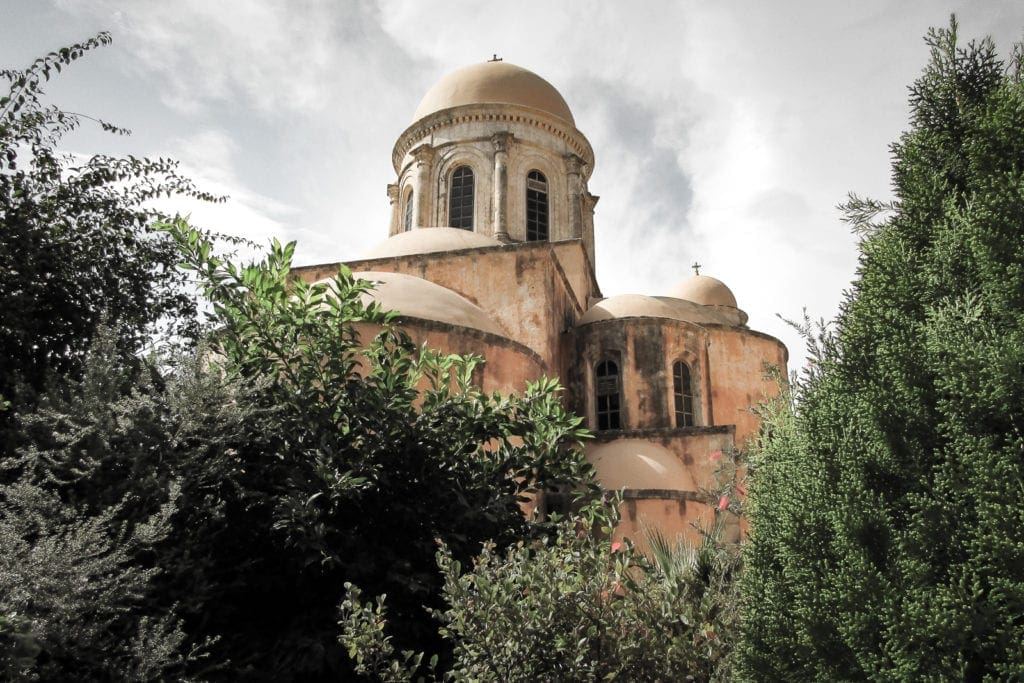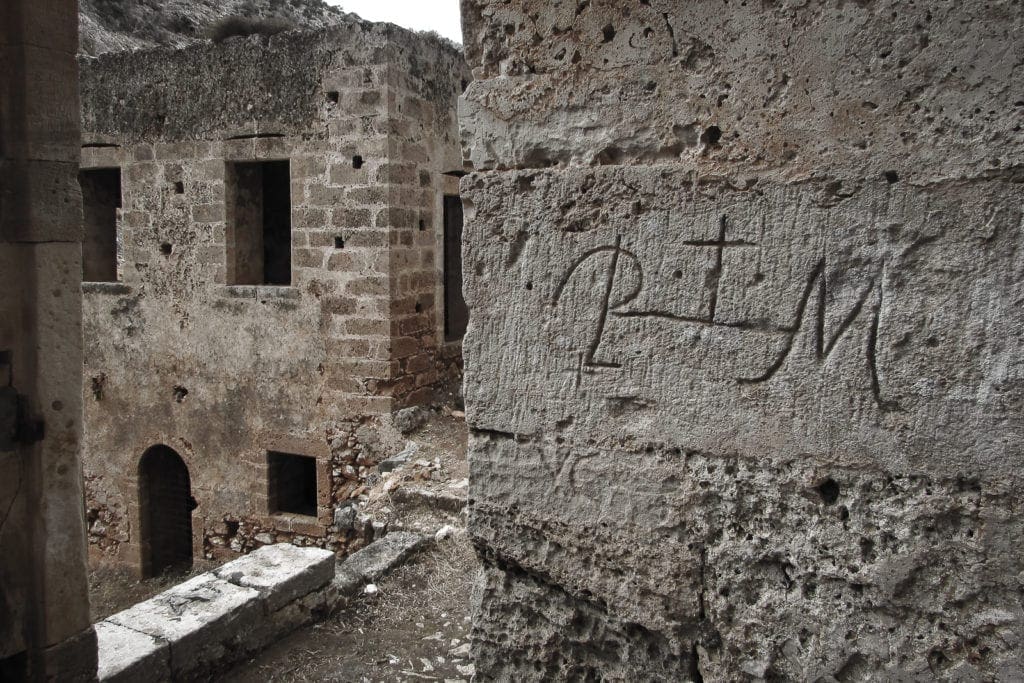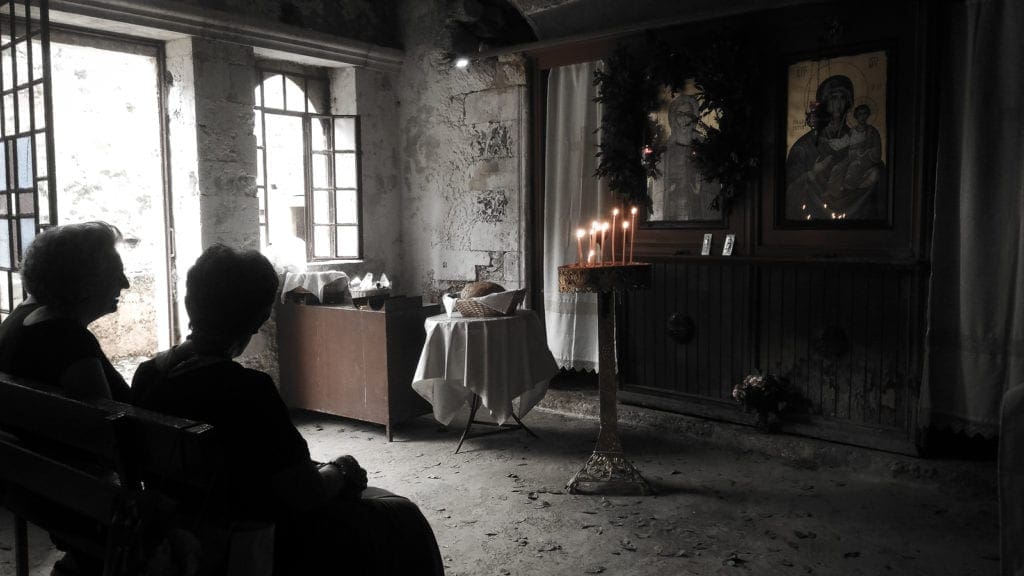In the sweltering heat of last summer’s aftermath, the stillness is broken only by the trembling bleating of distant goats. All around, the stony slopes of the Akrotiri peninsula plunge steeply into a cobalt-blue sea as the path unfurls downward, disappearing among thorny shrubs and piles of stones quivering with cicadas. Crete, behind us, is a sleeping mother turning her back on us, offering us a back of silver olive trees, and her profile fades along the horizon in a damp, azure mist. It seems we are alone in the world, lost in this strip of land that smells of resin and sea. This is a suggestion, probably, since we are not far from the island’s busiest town, Chania, and its international airport, which pours torrents of people into the island of Minos daily. Yet… Here, the passage of time has changed. We felt it on our skin as soon as we climbed the road up from the monastery of Agia Triada to the monastery of Gouvernetou, and then further along the twisted rope-like path that bypasses the Akrotiri promontory and slides down, down, down, towards the steep foothills of the Avlaki gorge, where sacred caves house ancient ascetic devotions and the remains of the old hermit monastery of Moni Katholikon. The silence here is almost a physical, vibrant entity.
Then, all of a sudden, a sound we don’t expect: crystal-clear laughter, a ringing Greek chatter. And three middle-aged ladies in sandals, wide dark skirts and umbrellas to shield themselves from the sun emerge like elves from around the bend, holding each other up. “Kalimera!” they greet us politely before disappearing down the path.
They leave behind a sense of dream and a trail of incense fragrance. “But where do they go?” asks Martin, looking at his hiking boots and thinking back to their sandals. I have no idea. We decide to follow them. We visited the monastery of Agia Triada only two hours earlier, the monastery of Gouvernetou even less, but they never seemed as far away as they did at that moment, as the shadow of the Avlaki gorge engulfs us, on the trail of the three women with their sharp laughter.

Of monasteries and hermits
Agia Triada is the most famous and most visited of the Orthodox monastic complexes on the Akrotiri peninsula, east of the Venetian city of Chania. Its square silhouette stands out in the barren landscape of vineyards and olive groves. In the past, it was a rich and flourishing monastic community. Today little remains of that power, just six monks under the leadership of Father Damaskinos and an echo of great peace within the yellow and reddish walls, on which a large Greek flag and the yellow flag with the black eagle of the Orthodox Church stand out. Amidst the shuffling tourists taking pictures of the building and courtyards, amidst the green of the orange trees and the fuchsia of the bougainvillaeas, the monks move peacefully and sternly in their black cassocks, thick grey beards and shoulder-length hair, caring for stray kittens in the shade of terracotta pots and chatting softly with the elderly gardener, toothless and sunburnt. When he sees us, sitting among the aromatics with our notebooks, the man approaches us, says something in Greek that we don’t understand and then, with a smile, hands us a lemon and goes back to his wheelbarrow. In Agia Triada, it is easy to think of spirituality as something reassuring: a lemon in the sun, a monk hanging out his cassock outside his cell, another carrying chicken feed, and a bright church of icons with a sky-blue background.
To get to Moni Gouvernetou, instead, you have to climb. Climbing upwards along a winding road that zigzags up the mountain, finally leading to one of Crete’s oldest fortified monasteries. It is massive, with the remains of towers in the four corners of the walls and an ascetic, remote atmosphere. But beyond the small door that leads to the courtyard – the only place, along with the church, where visitors have access – we see something moving. A few monks bustle around an icon decorated with fresh flowers. Worshippers light handfuls of long, slender candles, bend over the icon and kiss it with devotion, dip their fingers into the sugary bowl of pancakes and loukoumi that a tall, lanky novice with a gaunt smile hands out to anyone passing by, including us.
“Who’s this saint?” we ask him. But he doesn’t understand English well and we don’t speak Greek, so we switch to gestures. Finally the young monk’s face lights up, he’s talking to a companion, both of whom wave for us to follow. “How, how!” and then, “No photo,” and they lead us into the monastery church, jostle us in front of another icon depicting the same saint as just now: next to the painting, a small silver box bears a brownish dome on its lid. Some of the faithful enter, bow, mark themselves three times in the Orthodox manner and first kiss the icon, then the dome. Incense clouds the contours, an ancient psalmody can be heard in the background, a chorus of deep male voices, and the youngest guy watches us, waiting. He points to the icon, then to the silver box: «Great devotion» he explains, «St John the Hermit, great devotion». Then, since we still don’t get it, he tries to be more specific, touches his head, then points to the dome: “Head. St John’s head. Very important relic. You kiss it?». Fortunately, at that moment another worshipper claims his attention, he loses sight of us and we take the opportunity to say thank you and move away from the sacred skull.

Between East and West
We happened upon the celebrations for the feast of Crete’s most important ascetic saint by chance. And so we discover that we are still missing the last stop: the Moni Katholikon, built in the Avlaki gorge by the followers of St John the Hermit, the ascetic monastery later abandoned due to constant pirate raids.
It is along the path to the Katholikon that we find Arkouspilos, the Bear Cave with its tiny rock church, its smoky throb of forgotten candles and the stalagmite that, according to one legend, is none other than a bear petrified by the Virgin Mary for trying to steal drinking water from the well of the monks who lived in the cave. And here, too, we cross paths with the three ladies and decide to follow their voices.
For a few moments, we seem to have lost them, vanished in this suspended microcosm of Mediterranean scrub, so gentle and, at the same time, so harsh. Then the path suddenly changes to a steep stone staircase, more caves open up in the rocky mountainside, filled with candles and offerings: round buns, icons, and a few coins. Finally, a dulcet chant: and before our eyes, we see a small courtyard, the façade of a church carved into the rock, the remains of an old building now half crumbled by time, the Moni Katholikon, from the Greek word meaning ‘central’. The three ladies are inside. They have lit more candles, blown out the dust and leaves blown by the wind, and are singing hymns to St John the Hermit: they are preparing to welcome the worshipper who, that evening, will descend to the cave to pray. In a basket with a white napkin, a large loaf of bread stands out.
And as their harmonious voices hover in this stony cone of shadow where even the sun can no longer penetrate, as incense thickens into dense clouds between the mouldy walls of the old church and the long candles glow gold on the frames of ancient, moth-eaten icons, we suddenly understand what Nikos Kazantzakis meant when he called Crete ‘the perfect synthesis of East and West’. We listen to the women’s song for a few more minutes, then bow, light a candle, and finally turn back to the light to return to our journey.



